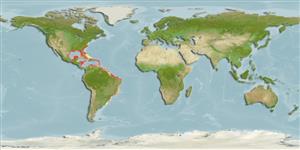Elasmobranquios (tiburones y rayas) (sharks and rays) >
Carcharhiniformes (Ground sharks) >
Carcharhinidae (Requiem sharks)
Etymology: Carcharhinus: karcharos (Gr.), sharp or jagged; rhinus, an ancient name for sharks, from rhine (Gr.), rasp, both words alluding to a shark's jagged, rasp-like skin (See ETYFish); acronotus: acro-, from akron (Gr.), top, summit or peak; notus, from notos (Gr.), back, allusion not explained, perhaps referring to “raised” (translation) back at first dorsal fin (See ETYFish).
More on author: Poey.
Environment: milieu / climate zone / depth range / distribution range
Ecología
marino asociado a arrecife; rango de profundidad 9 - 64 m (Ref. 50072), usually 9 - ? m (Ref. 55176). Subtropical; 40°N - 37°S, 100°W - 33°W (Ref. 55176)
Western Atlantic: North Carolina, USA to southern Brazil and Uruguay (Ref. 58839), including the Gulf of Mexico and the Caribbean.
Length at first maturity / Tamaño / Peso / Age
Maturity: Lm 110.7, range 87 - 137 cm
Max length : 200 cm TL macho / no sexado; (Ref. 244); peso máximo publicado: 18.9 kg (Ref. 40637); edad máxima reportada: 20 años (Ref. 108669)
Found on continental and insular shelves, mainly over sandy, shell, and coral bottoms. Feeds on small fishes, including pinfish (Sparidae) and porcupine fish. Preyed on by larger sharks. Viviparous (with a yolk-sac placenta), with 3 to 6 young per litter. Performs a 'hunch' display, with back arched, caudal lowered and head raised, as a possible threat display when confronted by divers. Utilized dried salted for human consumption. Minimum depth from Ref. 055176.
Viviparous, placental (Ref. 50449), with 3 to 6 young per litter (Ref. 244). Distinct pairing with embrace (Ref. 205).
Compagno, L.J.V., 1984. FAO Species Catalogue. Vol. 4. Sharks of the world. An annotated and illustrated catalogue of shark species known to date. Part 2 - Carcharhiniformes. FAO Fish. Synop. 125(4/2):251-655. Rome: FAO. (Ref. 244)
IUCN Red List Status (Ref. 130435: Version 2024-2)
Human uses
Warning: mysqli::__construct(): (HY000/1040): Too many connections in /var/www/html/includes/func_getlabel.php on line 46
Can't connect to MySQL database (fbapp). Errorcode: Too many connections
